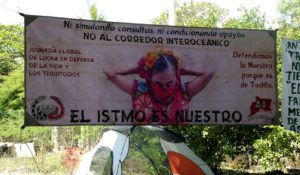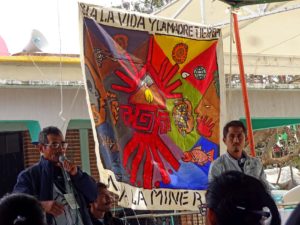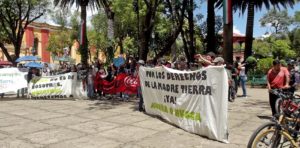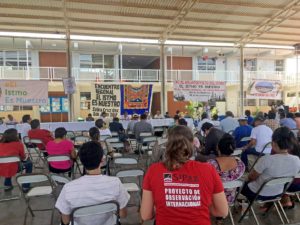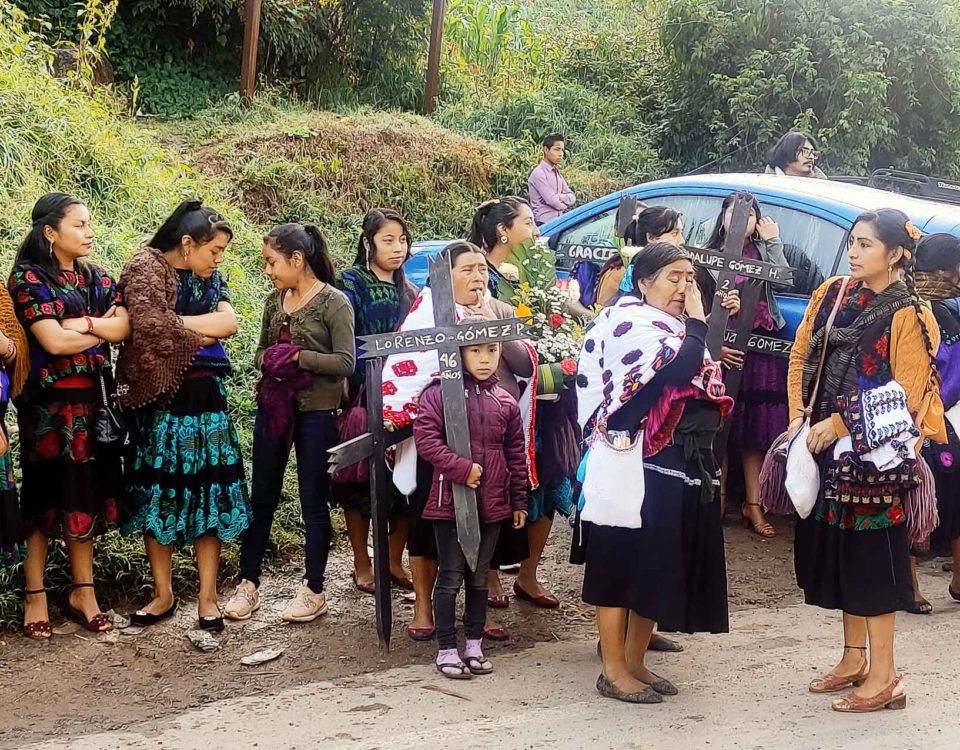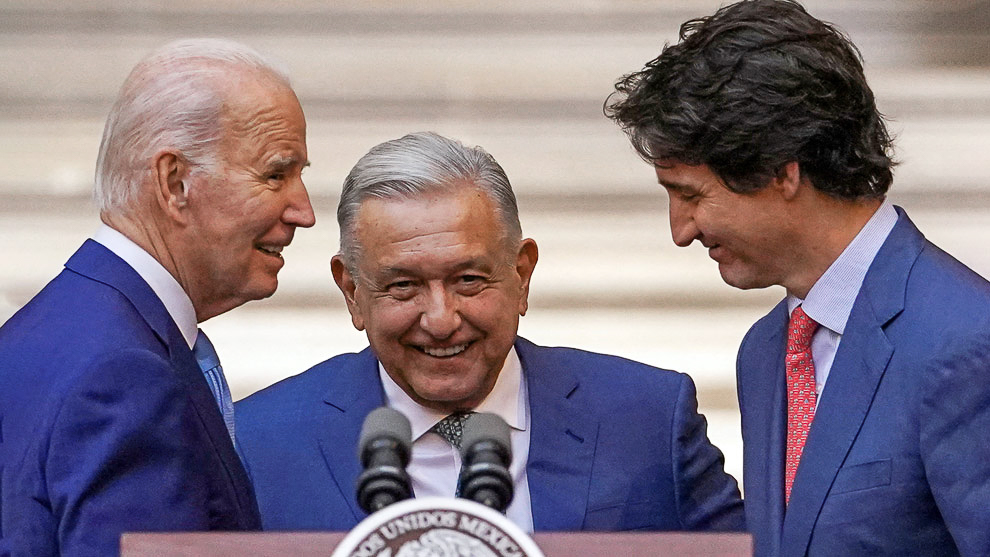
LATEST: 10th Summit of North American Leaders takes place in Mexico
09/03/2023
ARTICLE: The fight for justice in the Acteal Massacre case, an arduous path of a quarter of a century
09/03/2023When I defend the territory, I am defending my life. I am part of my territory and I am also territory, that is why it is important to defend life, the life of my community, the life of the land where I live and that is part of my existence.
In 2021 we contemplated with concern the multiplication of development projects and the erosion of the conditions under which people and communities who are defenders of the environment, land and territory do their work.
A ccording to the National Institute of Statistics and Geography (INEGI), Mexico is the fourth country worldwide with the greatest biological biodiversity. Thanks to its geographical location, relief and diversity of climates, the country has nine of the 11 types of ecosystems; about 200 thousand different species and is also home to approximately 12% of the biodiversity in the world.
For those who promote investments in Mexico, these conditions are an important source of resources that favor the development of productive and industrial activities. However, for those who defend territory, extractive, ecotourism and infrastructure projects have
become a high risk factor. In addition, in most cases, megaprojects represent a factor of conflict in the communities where they are carried out, even causing social polarization between those who agree with the project and those who do not. This, without leaving aside the constant violations of the human rights of the indigenous population.
Although Mexico has a Federal Mechanism for the Protection of Journalists and Human Rights Defenders since 2012 and has ratified the signing of the “Regional Agreement on Access to Information, Public Participation and Access to Justice in Environmental Matters in Latin America and the Caribbean”, known as the Escazu Agreement, in 2020 the figures show that the task of protection for defenders of territory has not been enough.
In 2021, Mexico became the most dangerous country for environmental and territory defenders, the international organization Global Witness warned in its report in 2022. There were 238 attacks against defenders, of which 25 were murders. Other attacks included intimidation, criminalization and an increase in forced disappearances: while two cases were documented in 2020, in 2021 the number rose to 20 disappeared defenders of the environment and the territory, reported the Mexican Center for Environmental Law (CEMDA).
Megaprojects and impunity, risk factors for the defense of territory
The current development model in Mexico is not new, since it has been promoted for decades by other governments. An example of this are the peoples of the Tehuantepec Isthmus in Oaxaca, who since the time of Porfirio Diaz have been victims of a series of implementations of supposed development projects. However, the political proposal of the Fourth Transformation (4T) of the current president, Andres Manuel Lopez Obrador, stands out for being “one of the points of greatest social conflict” expressed mainly by the rejection and questioning – on the part of some sectors of the population – of the projects they want to promote, explain Aleida Azamar Alonso and Carlos A. Rodriguez Wallenius, academics from UAM-Xochimilco.
Azamar points out that there are at least 1,600 projects and megaprojects on the national agenda to be carried out, with the Maya Train, the Tehuantepec Isthmus Interoceanic Corridor (CIIT), the Santa Lucia international Airport and the Dos Bocas refinery being those with the greatest environmental impact.
This development model privileges extractive activities over the ways of life of the individuals, peoples and communities, and in turn generate processes of legitimate resistance for the protection of their territory, their resources and, in general, their ways of life, explains CEMDA. Currently, the implementation of megaprojects such as the CIIT, hydroelectric plants and mining has had an impact on communities related to violence against defenders of territory because it creates a climate that does not help them carry out their work. On the contrary, it allows them to be harassed, persecuted, defamed and even killed, says Marcos Leyva Madrid, director of Services for an Alternative Education (EDUCA).
Since Andres Manuel Lopez Obrador took on the presidency in 2018, 45 people have been killed for defending their territories. However, this figure is “conservative” because it only includes beneficiaries of the Defense Mechanism. CEMDA’s record rises to at least 58 environmentalists executed in the same period, who for the most part have not obtained justice.
The director of EDUCA points out that this is another of the factors involved in attacks on defenders, the large percentage of impunity that exists and that, in places like Oaxaca is the result of cacique politics that continues to exist in many other places.
The main aggressors of defenders of the environment and territory
According to a Forbes article, “at least 40% of the assaults committed against environmental defenders in Mexico come from state officials, particularly from local authorities.” Gabriela Carrion from CEMDA pointed out that in 8.3% of the cases the aggressions come from organized crime and in 5.6% of cases, from companies, and in the majority of cases —38.9%— the aggressors were not identified.
Jesus Peña, deputy of the United Nations High Commissioner for Human Rights in Mexico, spoke of “stigmatizing statements by public officials” as another cause of the high number of attacks against defenders in the country. Such is the case of the Secretary of the Environment and Natural Resources (SEMARNAT) who, in 2022, called a group of artists who disagreed with the Maya Train “pseudo environmentalists”, and accused them “of engaging in misinformation or promoting misinformation”, Forbes Mexico wrote.
In addition, Lopez Obrador accused the United States government of being behind the groups opposing Section 5 of the Train. “From Mexico City and various parts of the country there are pseudo-environmentalists funded by the United States government and they forward these injuncions against us. So a procedure established by law is used, which is to declare this work of national security (…)”, he pointed out in one of his morning press conferences.
Adriana Cadenas, coordinator of the Tskini organization in Jalisco, pointed out that in some cases there is collusion between various players, such as organized crime and companies, to intimidate, harass and threaten communities that oppose these projects. Cadenas mentioned that in the Sierra de Manantlan, “[the mining company] has colluded, has called on the services of organized crime as an armed wing to intimidate, threaten the population that is against these mining operations, to threaten and intimidate them so that they desist from this defense.”
On the other hand, the organizations insist that the role of the federal authorities and state agencies, in charge of granting permits to companies and regulating their actions to ensure that projects comply with the law, also generate greater socio-environmental conflict, since in most cases, none of these tasks are carried out.
Territories and indigenous defenders, the most affected by megaprojects
According to INEGI, 39% of the forests and 60% of the jungles are in indigenous territories. These regions also capture 23% of the country’s water, and a large part of the wealth of the subsoil and air is found in these territories. For Global Witness, this has turned indigenous territories into highly vulnerable places in the face of the growing number of extractivist projects promoted by national and foreign companies, and supported by the Mexican government. Almost half of the attacks registered in 2021 were against indigenous communities, and conflicts over land and mining were linked to two thirds of the lethal attacks, the organization reported.
According to the National Commission for the Development of Indigenous Peoples (CDI), Oaxaca ranks first in the country in terms of indigenous population. According to the report “Situation of People and Communities Defending Environmental Rights in Mexico”, this state is also in first place in terms of attacks on environmental defenders with 24 cases registered in 2021. Marcos Leyva stated that in the last four years of the state government of Alejandro Murat, 33 defenders of human rights in Oaxaca were killed, turning it into a black spot for the defense of the territory.
Global Witness points out that the state is home to one of the most lethal projects: the Paso de la Reina hydroelectric plant. In this region of the Pacific Coast, Mixtec, Chatino and Afro-Oaxacan communities have organized around the defense of their territories, including the Rio Verde. The resistance actions by members of the Council of United Peoples for the Defense of Río Verde (COPUDEVER) claimed the lives of five defenders from January to March 2021: Fidel Heras Cruz, Jaime Jimenez Ruiz, Raymundo Robles Riaño, Noe Robles Cruz, Gerardo Mendoza Reyes, and also Filogonio Martinez Merino, in October of the same year. They all belonged to indigenous communities. They are all cases that remain in impunity.
Although murders are the most violent kind of aggression against defenders, the criminalization of social movements is also a worrying factor and, in some cases, CEMDA points out, the judiciary helps to validate them. Recently, the Assembly of Indigenous Peoples of the Isthmus in Defense of Land and Territory (APIIDTT) denounced the illegal detention of David Hernandez Salazar, defender of the territory against the Tehuantepec Isthmus Interoceanic Corridor. The arrest was carried out by alleged persons of the Oaxaca Prosecutor’s Office. However, several hours passed before finding the whereabouts of the defender, for which the organization denounced his deprivation of liberty, as well as the existence of 17 arrest warrants against other residents of Puente Madera and members of the APIIDTT, who denounced harassment and surveillance by armed persons in their offices.
Xavier Martínez, from CEMDA, said that in order to advance in the construction of a safe environment for environmental and territory defenders “it is necessary to stop their stigmatization and their criminalization”.
Erick Ramirez, a Binniza community member on Tehuantepec Isthmus, spoke in an interview with Desinformemonos about the division that exists in the communities, the lack of attention from the authorities and the criminalization of which they are victims: “For us, for opposing, they discredit us, they say many things about us and they attack us”, stated the defender.
Rosa Marina Flores, a member of the APIDDTT, affirms that the strategy of the 4T has been carried out from social programs —on average 1,051,020 people have benefited from some social program launched by the AMLO government. The concern arises as it is “generating a very strong dynamic of clientelism in the territories”, says Flores. In addition, they have caused an increase in conflict in the communities and the confrontations “between those who are against or in favor of the megaprojects”, since even the same people from the communities monitor those who oppose the policies of the federal government, she concludes.
Megaprojects behind a systematic violation of human rights
In a joint report, COPUDEVER, EDUCA and the Mexican Movement of People Affected by Dams and in Defense of the Rivers (MAPDER) denounced the systematic violation of the rights of the Indigenous peoples. In the case of hydroelectric projects, violations have been documented of at least eleven of these rights, including the right to self-determination, to information and participation, the right to water, to development, to a healthy environment, to nutrition, health and work.
This situation became more serious after the federal government published a presidential decree in 2021 in which the projects and works that the government is in charge of are considered priorities and strategic, for which reason the order was given to grant the necessary authorizations, including environmental ones “within a maximum period of five days”, explained CEMDA. With this Agreement “the rights of the indigenous peoples and communities related to territory and autonomy are violated”, the report highlights.
Flores Cruz adds that the militarization that is taking place in the country is added to this panorama, which complicates the situation even more, since as the director general of the CIIT, Rafael Marin, commented, with this presidential agreement, not only would the procedures and times that prevent the progress of the works be reduced, but “it will also guarantee the rapid intervention of the authorities to contain probable road blockades.”
The most recent case is that of Palomares, an ejido in the municipality of Matias Romero, on the Isthmus of Oaxaca, where the armed forces were used to impede the right to free protest. There, ejidatarios who mobilized to prevent the CIIT works were evicted with blows and pushed by elements of the Secretary of the Navy, reported the Union of Indigenous Communities of the North Zone of the Isthmus (UCIZONI).
Another of the distinctive megaprojects of the 4T is the Maya Train, where the main question has been the lack of information and consultation with the affected populations. Carlos Rodriguez Wallenuis, a professor at UAM-Xochimilco said that to date there has been no prior, free and informed consultations, not even with the indigenous communities “to which the the State is obliged to ask, according to Convention 169 of the International Organization for Labor (ILO)”.
In this case, citizens, non-governmental organizations and communities demonstrated that several sections of the Train did not have the approval of the Environmental Impact Statement (EIS) when the works began. This forced the granting of various injunctions that required companies and the government to stop work. However, that did not happen and in all cases, the work continued, remarks CEMDA in its report. It is a case of “proceedings that are not carried out legally, that are not culturally appropriate, that do not respect rights to information, participation or autonomy and which, in general, do not adhere to the constitutionally established standard of protection”, the organization said.
CEMDA assured that “many of the human rights violations against indigenous peoples and rural communities have been perpetrated within the framework of the development of megaprojects”, being part of a system that generates structural violence, “of a system of law that legitimizes violence to exploit people, peoples and nature”.
Legal loopholes in the protection of defenders
2021 stands out for also being the year in which Mexico ratified the Escazu Agreement, a treaty in Latin America and the Caribbean that, for the first time, recognizes human rights defenders human rights in environmental issues and obliges States to protect them. The Agreement had to face various obstacles, including the presidential decree on the priority of megaprojects, but also that of a possible ruling by the Supreme Court of Justice of the Nation that addresses the power of organizations to express their disagreement with environmental decisions. If there were a ruling in favor, it would be acting with respect to the Escazu Agreement, otherwise, it would represent legal risks for the megaprojects promoted by the government of President Andres Manuel Lopez Obrador.
Alejandra Jimenez, from the Regional Coordinator of Solidarity Action in Defense of the Territory Huasteca-Totonacapan (CORASON) criticized the application of the Agreement and said that “Until now, the The Escazu Agreement has existed only in words, this is the story of many laws in Mexico. It is evident what has happened with the violence that defenders have experienced. And let’s not even mention access to information, there are even setbacks. There is an environment that hinders very much.”
Although this Agreement is not just about the protection of defenders, it is a fact that it is one of the most urgent elements to attend to. In this sense, Gustavo Alanis Ortega, director of the Mexican Center for Environmental Law (CEMDA) claimed that there is a silence on the subject, especially from the Ministry of the Interior, the agency in charge of Protection Mechanism for Human Rights Defenders and Journalists, a tool created by the government to protect the life and integrity of activists.
According to Reporters Without Borders, 1,667 people were under the protection of this Mechanism in 2022. Among the measures offered is that of offering cell phones, radios or satellite phones; of cameras, panic buttons or other security facilities in place of residence and/or work; the offer of bulletproof vests and the use of bulletproof cars, the organization explained.
Despite this, activists and civil society organizations have denounced that these measures are not enough to combat the structural roots of this violence. In other cases, the Mechanism acts too late. For example, after the murders of his companions In Paso de la Reina, Filogonio Martinez Merino asked for protection for himself and his family, “however, (…) it took them more than a year to carry out the risk analysis” and meanwhile Filogonio was assassinated, lamented EDUCA Oaxaca.
“The mechanism leaves much to be desired”, says researcher Lucia Velazquez, “the defenders are not given adequate follow-up. It has not served to protect them.”
Defense of territory is the defense of life
Environmental and territory defenders face increasing risks in the protection of their territories. Under the discourse of development are hidden interests of large companies and the government at all levels, but also organized crime groups and caciques who demand their share of the profits. Despite this, communities come together to share their knowledge, to dialogue, to find out about the damage to their health and the environment caused by these projects.
In Oaxaca, it was during the “10th Meeting of Community Defenders” where they spoke of the pain and wounds that the process has left them and the struggle in defense of their territory. They talked about the importance of women’s participation because they are the ones who care for, work and know their territory, said Angelica Castro Rodriguez of EDUCA.
In Chiapas, the Movement in Defense of Life and Territory (MODEVITE) has been opting for non-violence for the care of their territory for almost ten years given the threat of megaprojects: “Given this reality of violence and confrontation, MODEVITE reiterates its commitment to the defense of the territory through NON-VIOLENCE and in the construction of PEACE in our peoples”, they explained.
In 2017 the National Encounter Against the Extractive Mining Model was held in Guerrero, where the participants endorsed “that the defense of the territory is the defense of life; that defending the ancestral territory is also protecting the culture and, therefore, means our permanence as peoples.”


